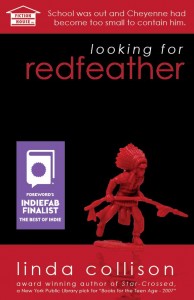November is National Novel Writing Month (NaNoWriMo). Right now thousands upon thousands of stories are being spilled onto the screen as writers around the world commit to 50,000 somewhat meaningful and related words in thirty days. In 2007 I answered the call, writing the first draft of Looking for Redfeather during the month of November. It took 72 more months to revise, edit, and publish the book!
I’ve been asked to lead a writers’ workshop for the students at Prospect Academy next week — the topic being How to Write a Novel.
The workshop is next week, so I’ve been gathering my notes and my thoughts. What will I say to these young writers? How do you write a novel?
There are three rules for writing a novel — unfortunately no one knows what they are. — a humorous quip attributed to Somerset Maugham. I’m going to put a little spin on that and say no one can agree what they are. Because there’s a lot of advice floating around on blogs and social media about how to write a novel. A lot of “should” and “shouldn’t, “must” and “must not” to freeze your fingers and stop your imagination cold. The most ardent advice seems to come from self-styled writing experts. Beware!
The truth is, there are no rules for writing a novel. It’s up to you to capture the essence of your story the best way you can.

Now that we’ve established there are no rules and given you the freedom to write whatever you want to, a few guidelines might help you complete your novel. Some writers like to have structure. They make detailed outlines, conform to an established story arc, and interview their character for back story. Their MO is to write a complete narrative outline first, before going back and fleshing it out with details and dialogue.
At the opposite end of the spectrum are those adventurous souls who sit down and let their fingers do the walking across the keyboard, channeling the characters in their imagination and trusting them with the story line.
Whether you plot everything out in advance and follow the golden story arc– or write by the seat of your pants, or use a combination of the two, it really doesn’t matter. The process of many writers (this writer) falls somewhere in the middle of the two extremes. Either way, the process isn’t linear and becomes messy with successive re-writes. (Like time travel, if you change something in the past it alters the present and the future!) The only thing to do is to write your way out of it.
It might make you feel more confident to remember no novel is perfect; the perfect novel cannot be written. Once you accept that, it gets easier. Well maybe not easier but there is one less obstacle in your way.
Here are a few suggestions I can offer, from my own experience:
A novel is easier to write if you can conceive of the three P’s: A person in a particular place with a particular problem.
Write about a character who interests you, intrigues you, or whom you care a great deal about. Allow that character to come to life and direct their own story. The character can be based on yourself or someone you know — or a combination of people. The character will begin to develop on the page, trust me. Even if you’ve modeled the character after a real person, your fictional character will become unique. Yes, it’s magic.
Get your story out of your head and down on paper or the computer screen. Resist the urge to talk about your story; you’ll lose the fire.
Don’t feel compelled to write chronologically. Even if you are using an outline or other structure, write the part that speaks to you, first.
Try writing the whole story before you begin to revise and edit. This is not a rule, but a suggestion. I know one excellent writer who never goes to the next chapter until the first one is pretty much perfect. The problem I’ve found with that approach is I never get the story finished! What works for me is to capture the heart of the story, the spirit that makes it alive and unique, by writing a beginning, middle and end — and then going back and beginning the many revisions that are necessary. My first drafts aren’t very long — sometimes less than half the length of the finished novel. In that respect a first draft is kind of like an outline that needs to be filled out and expanded upon.
If one method isn’t working, try something else. Read another author for inspiration. Start over, if you have to (we’ve all done it!) But keep writing. Persevere. Write to discover.
Looking for Redfeather, my 2007 NaNoWriMo book, was a Foreword Reviews finalist for Book of the Year, YA category, in 2013. Check out the audiobook, narrated by actor Aaron Landon!
